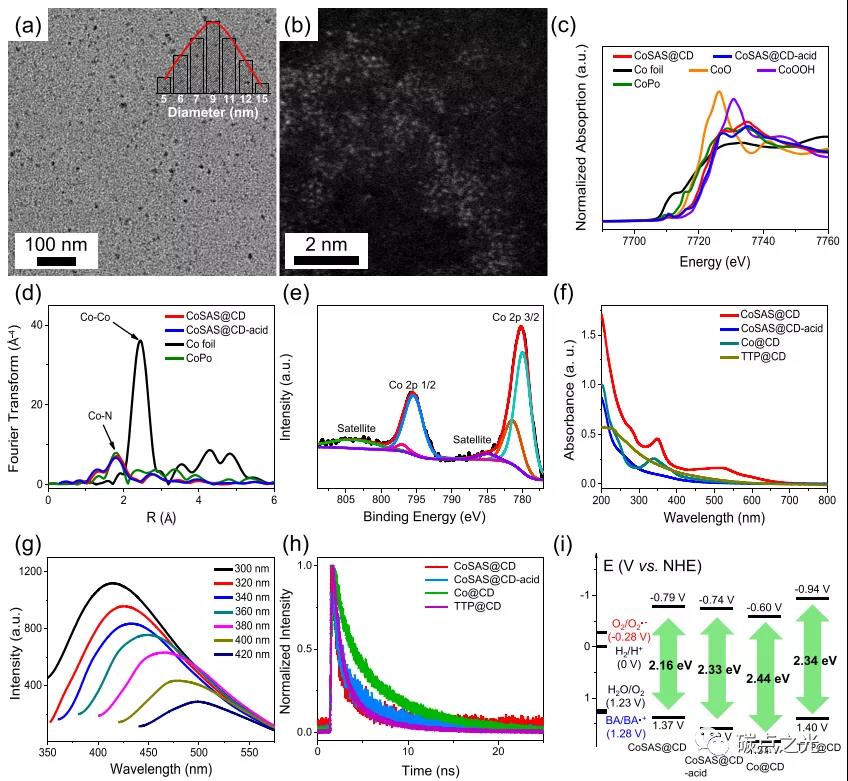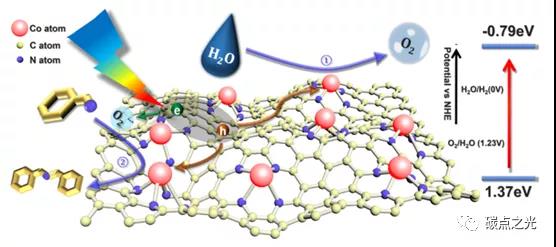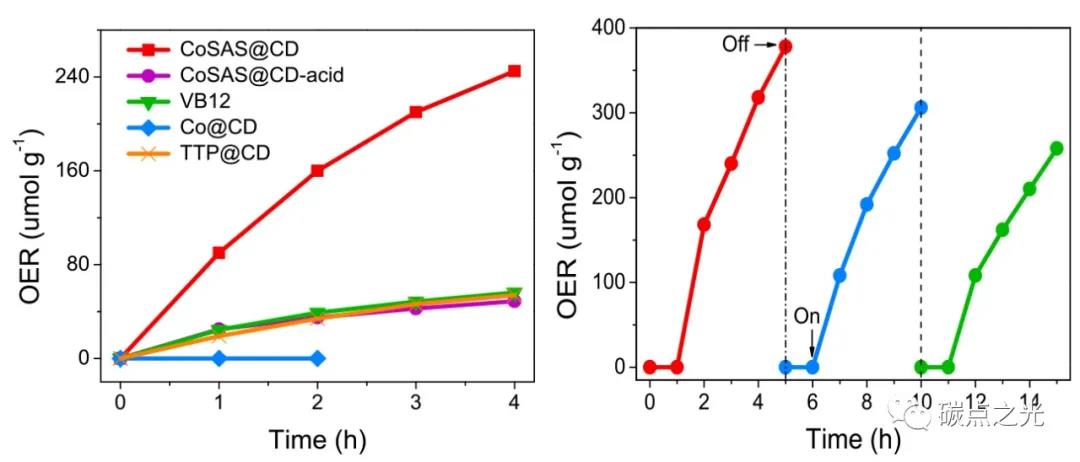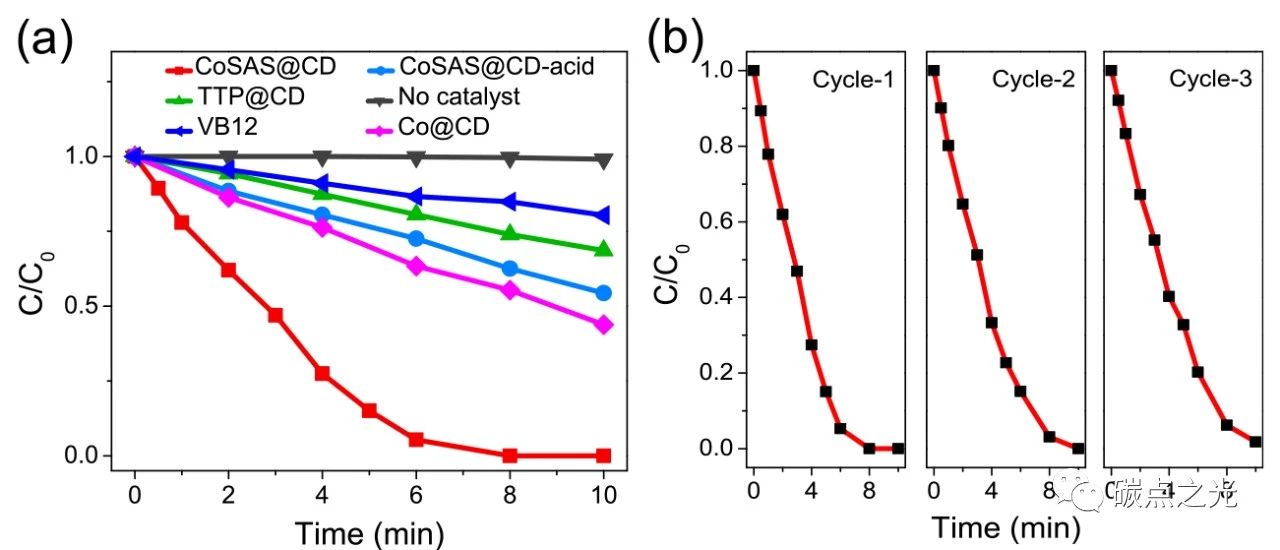Professor Li Run of Hunan University in Chem. Mater.: Carbon quantum dot anchored monoatomic cobalt: high-efficiency photocatalyst for visible light catalytic oxidation reaction
QQ Academic Group: 1092348845
Detailed
Carbon quantum dots (CQDs) have become a promising candidate for solar conversion photocatalysts due to their advantages of convenient preparation, low cost, good stability, high quantum yield, non-toxicity, high water affinity, and visible light absorption. Monoatomic catalysts have become a new active frontier in heterogeneous catalysts due to the highest possible atomic utilization, which can be used to produce ideal products with high selectivity and conversion, while increasing the number of available catalytic centers. Due to changes in the structure of electrons and energy levels, the intrinsic activity of coordination atoms may be enhanced. The introduction of a single metal atom on the photocatalyst can lead to extremely high atom utilization rate and precise active center, however, there is still a lack of photosensitizers suitable for fixing single atoms. Previous reports have focused more on the use of g-C3N4 as a matrix-supported single atom for photocatalysis, but the low single-atom loading on g-C3N4 has limited its photocatalytic applications.
Recently, Professor Li Run of Hunan University optimized the structure of CQDs carbon core, using the natural porphyrin ring in vitamin B12, the first successful preparation of a new metal-atom Co-loaded new CQDs photocatalyst material (CoSAS@CQDs). Studies have shown that the monoatomic cobalt is anchored on the surface of CQDs to form a Co-N4 structure, reaching a high atomic loading of 3.17wt%. CQDs can be used as both a light-harvesting agent and a support for monoatomic cobalt. Monoatomic cobalt can Enhances light-induced charge separation and promotes charge transport within the material, where photo-generated hole species can be concentrated on a single cobalt atom as a catalytic center. The synergistic effect of single cobalt atoms and carbon dots makes the photocatalyst have a good effect on the oxidation reaction promoted by visible light Catalytic efficiency, to study its water oxidation, oxidative coupling of aromatic amines and photodegradability of organic pigments, monoatomic cobalt anchored on CQDs showed high stability in three oxidation reactions. It is envisaged that this method of anchoring a single metal atom to a carbon point will be applicable to other metal atoms, which can provide a new platform for photocatalysts whose atoms are anchored to metals. Related achievements were published in Chemistry of Materials as "Single Atomically Anchored Cobalt on Carbon Quantum Dots as Efficient Photocatalysts for Visible Light-Promoted Oxidation Reactions".

Figure 1: The morphology, basic physical and optical properties of CoSAS@CQDs

Figure 2: Photocatalytic oxidation of CoSAS@CQDs, for example, oxygen evolution and oxidative coupling of benzylamine

Figure 3: Photocatalytic oxygen evolution reaction

Figure 4: Efficiency of photocatalytic degradation of RHB
Article links: Qin Wang, Jin Li, Xianjun Tu, Hongbo Liu, Miao Shu, Rui Si, Calum TJ Ferguson, Kai. AI Zhang, and Run Li. Single Atomically Anchored Cobalt on Carbon Quantum Dots as Efficient Photocatalysts for Visible Light-Promoted OxidationReactions. Chem. Mater. 2020, 32, 734−743.
Recently, Professor Li Run of Hunan University optimized the structure of CQDs carbon core, using the natural porphyrin ring in vitamin B12, the first successful preparation of a new metal-atom Co-loaded new CQDs photocatalyst material (CoSAS@CQDs). Studies have shown that the monoatomic cobalt is anchored on the surface of CQDs to form a Co-N4 structure, reaching a high atomic loading of 3.17wt%. CQDs can be used as both a light-harvesting agent and a support for monoatomic cobalt. Monoatomic cobalt can Enhances light-induced charge separation and promotes charge transport within the material, where photo-generated hole species can be concentrated on a single cobalt atom as a catalytic center. The synergistic effect of single cobalt atoms and carbon dots makes the photocatalyst have a good effect on the oxidation reaction promoted by visible light Catalytic efficiency, to study its water oxidation, oxidative coupling of aromatic amines and photodegradability of organic pigments, monoatomic cobalt anchored on CQDs showed high stability in three oxidation reactions. It is envisaged that this method of anchoring a single metal atom to a carbon point will be applicable to other metal atoms, which can provide a new platform for photocatalysts whose atoms are anchored to metals. Related achievements were published in Chemistry of Materials as "Single Atomically Anchored Cobalt on Carbon Quantum Dots as Efficient Photocatalysts for Visible Light-Promoted Oxidation Reactions".

Figure 1: The morphology, basic physical and optical properties of CoSAS@CQDs

Figure 2: Photocatalytic oxidation of CoSAS@CQDs, for example, oxygen evolution and oxidative coupling of benzylamine

Figure 3: Photocatalytic oxygen evolution reaction

Figure 4: Efficiency of photocatalytic degradation of RHB
Article links: Qin Wang, Jin Li, Xianjun Tu, Hongbo Liu, Miao Shu, Rui Si, Calum TJ Ferguson, Kai. AI Zhang, and Run Li. Single Atomically Anchored Cobalt on Carbon Quantum Dots as Efficient Photocatalysts for Visible Light-Promoted OxidationReactions. Chem. Mater. 2020, 32, 734−743.
https://pubs.acs.org/doi/pdf/10.1021/acs.chemmater.9b03708
Source of information: Carbon Point Light
This information originates from the Internet for academic exchange only. If there is any infringement, please contact us to delete it immediately
- Previous: Flexible implantable n
- Next: A Rising 2D Star: Nove


 Academic Frontier
Academic Frontier